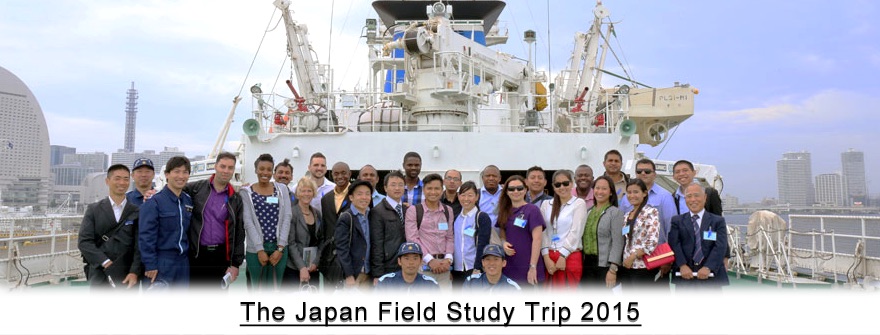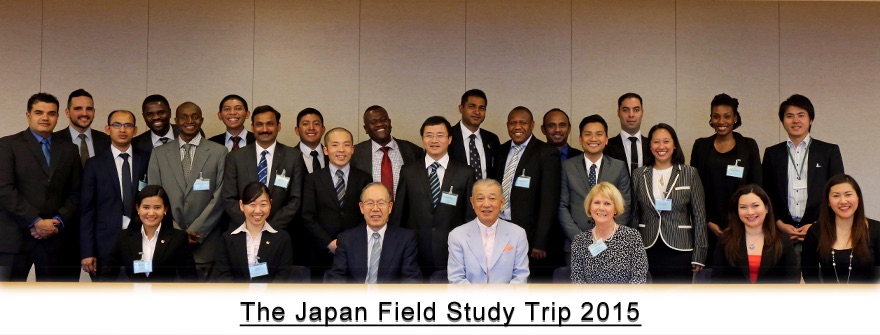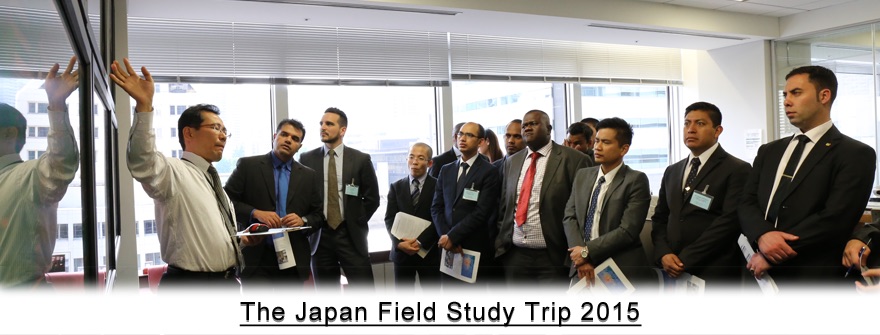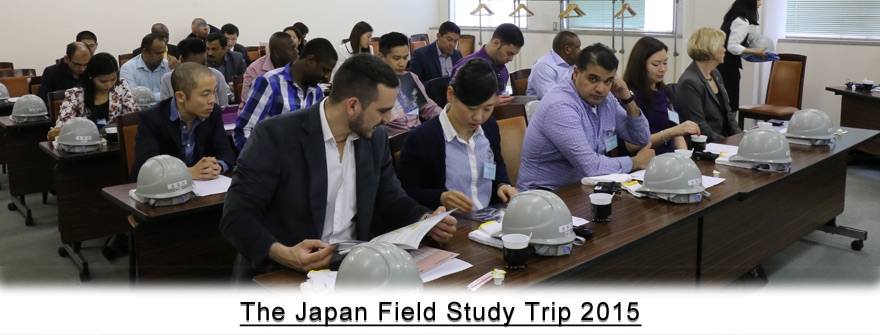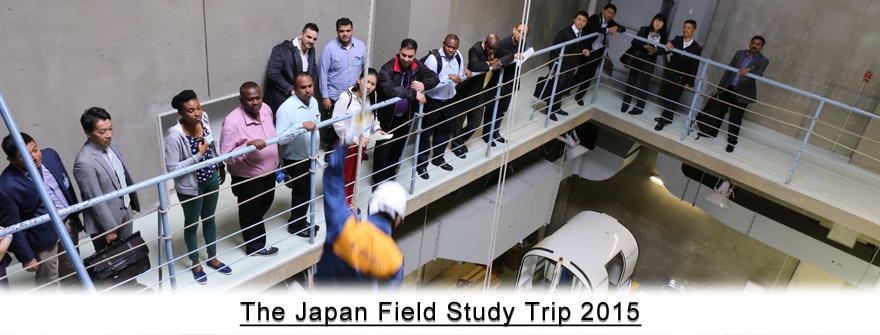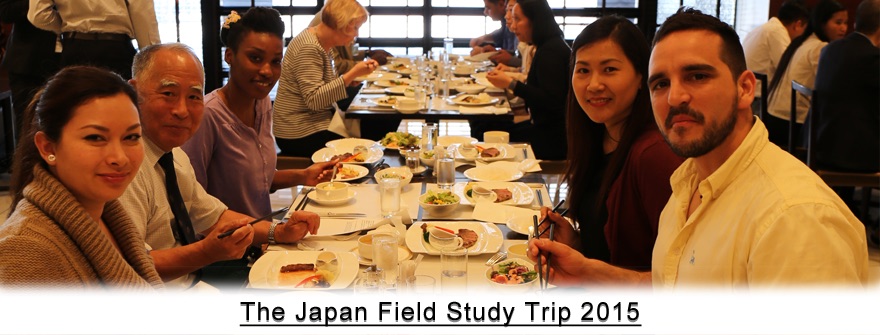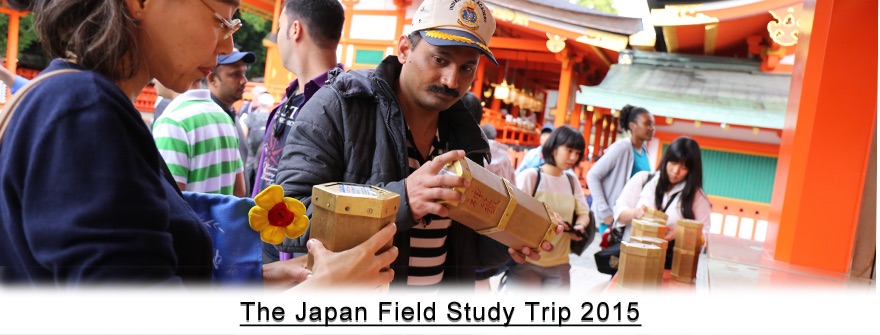Japan Field Study Trip
Japan Field Study Trip 2015
Saturday and Sunday 9-10 May: the journey and arrival
22 excited students and one tense member of staff meet at Triangeln station for the start of the long journey to Tokyo. What does the week ahead hold for us? Will we cope with chopsticks? (student concern!) Will everyone be on time for our appointments? (Lyndell's concern!) One thing we are sure of: the welcome from the Sasakawa Peace Foundation will be warm.Sure enough, on arrival at Tokyo Narita airport after our long flight, we were welcomed by the smiles of Mr Shinichi Ichikawa from SPF and Ms Miyoko Wada, our tour guide for the week. And so it began, the counting of heads: ichi, ni, san, shi…
Arrival at the Shinagawa Prince Hotel was a delight. Firstly, because we were met by another smiling face, Mr Eisuke Kudo, and also by a welcome buffet lunch served high up in the hotel with a stunning view over Tokyo. What a start to our week!
Tokyo, Monday 11 May: the BIG day
This day had been so carefully prepared for us. We spent the morning at the Ministry of Land, Infrastructure and Transport, where Mr. Takayuki Ikeda shared a lot of information with the students in answer to questions they had submitted in advance. Mr Ali Juma gave some words of appreciation on the students' behalf. Lunch was followed by a visit to Mitsui OSK Lines, and after that we were bussed to our much-anticipated visit to The Nippon Foundation and meeting with Dr Yohei Sasakawa.We were rather nervous waiting, but Dr Sasakawa quickly put us at our ease. Each student introduced themselves and then Dr Sasakawa gave an address outlining his philosophy of ocean research and philanthropy. Ms Fatima Angeles spoke on behalf of the students, noting how they looked forward to making good use of the opportunities they had been given. The hour passed all too quickly.
A Welcome Reception was held that evening and again the students and I were touched by the warm greetings of senior representatives of The Nippon Foundation and the Ministry of Land, Infrastructure and Transport, WMU graduates, members of the Tokyo diplomatic corps and local maritime industry representatives. Mr Mukund Gujar delivered an address from the students, voicing the student perspective of their visit to Japan and their futures in the maritime industry. A particular highlight was a senior choir performing sea shanties with great gusto and skill. The WMU students were able to reciprocate with a spirited rendition of the WMU song, joined by the WMU graduates and by the senior choir. It was a very happy evening.
Tokyo, Yokohama, Tuesday 12 May
Tuesday morning was spent at the Japan Marine United Corporation Tsurumi Works where we were given a very interesting tour of the shipyard. The students and I were very impressed by the range of constructions in progress.The afternoon was spent in Yokohama, firstly at the Marine Disaster Prevention Facility and later at Yokohama Port. We were so interested to see this famous port and its facilities: a bonus was the tour of a Coast Guard vessel. Our day was made complete by a very pleasant boat tour of Yokohama harbour.
Tokyo, Yaita, Wednesday 13 May
On Wednesday we travelled outside the city to visit Tokyo Keiki Inc. Yaita Works. We were greeted there with great warmth by Tokyo Keiki staff and shown the manufacture of intricate instruments such as the gyrocompass – used so very often in marine navigation. Back in the meeting room, Mr Kudo suggested we should sing the WMU song for Tokyo Keiki staff: we were getting used to performing!Travelling to Tokyo Keiki in Yaita also gave us a chance to see some of the countryside. When one is in such an urban environment as Tokyo, it is easy to forget that the majority of land in Japan is in fact covered by forest. Travelling through forest and green fields was such a contrast, and very refreshing.
Tokyo to Kobe, Thursday 14 May
Up early and off! We hurried to the railway station to catch the Shinkansen (bullet train) towards Kobe. Boarding the train is an art: precision of platform placement and swift embarkation are essential. No wonder our big suitcases had been sent ahead by bus! We enjoyed the train ride: wonderful views of beautiful Mt Fuji and again the opportunity to see the countryside.We alighted at Aioi station and visited "Spring 8", which is the world's largest synchrotron radiation facility. The science was a little foreign to us but we could understand that a very high level of research was carried out there. We were interested to see the use of this impressive facility by a wide range of companies and institutions.
Our day concluded with a visit to Himeji Castle. How beautiful! Set upon a hilltop in Hyogo Prefecture, the castle has been likened to a white heron. The graceful curves of its white roofs emerge from the surrounding gardens with such elegance. The Castle was listed as a UNESCO World Heritage site in 1993 and when we saw it, a five–year renovation had just been completed. It is simply lovely.
Kobe, Friday 15 May
With two "academic" visits on the schedule, this day felt like coming home. Firstly we visited the Kobe Marine Technical College where the welcome from former WMU Professor Toshio Hikima and his colleagues was hearty to say the least. It was interesting to see the campus and note the similarities (and differences) to WMU. The afternoon was spent at Kobe University's Graduate School of Maritime Sciences, where we listened to interesting presentations by PhD candidates.We spent the evening as the guests of the Japan Marine Equipment Association. Representatives of 9 companies were present, including the Nakashima Propeller Company – famous to WMU students for the propeller standing outside our new building. The event was successful and again, we were treated to fine hospitality. At Mr Kudo's suggestion, we thanked them by singing the WMU song…
Kyoto, Kobe and away to Copenhagen, Saturday 16 May
An early start was richly rewarded. We visited Kyoto, former capital of Japan, full of historical interest. Our first visit was to Fushimi Inari Taisha where long rows of vermillion Shinto “gates” snake their way through the forest.Second was a visit to Kiyomizu-dera Temple. Set in beautiful gardens, the traditional temple architecture was breath-taking. Many students queued to drink water that guarantees longevity: others simply enjoyed strolling through the gardens, marvelling at the number of couples dressed in traditional Japanese kimonos. The market area outside the temple precinct was also of great interest for souvenir hunters!
Our final day concluded back in Kobe with a Reception attended by many SPF friends and well-wishers. Diana Henry gave the farewell address on behalf of all the students, thanking everyone for a week that would live in our memories and hearts forever. Again, the WMU song!
Then for the last time, …ichi, ni, san, shi… and we were on our way home.
Our heartfelt thanks for the generosity extended to us by The Nippon Foundation, the Ministry of Land, Infrastructure and Transport, all our wonderful site hosts and most of all to Mr Kudo, Mr Ichikawa and Ms Wada. Special thanks too to our own students Maki Tominaga and Sadaharu Koga for answering all our questions with such patience.
Arigato gozaimasu!
Lyndell Lundahl
Assistant Registrar (Student Services)
World Maritime University
